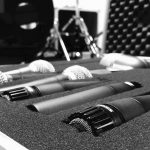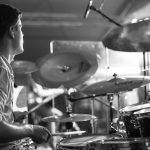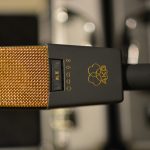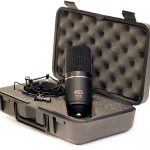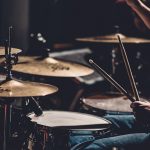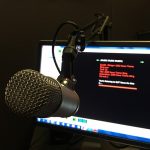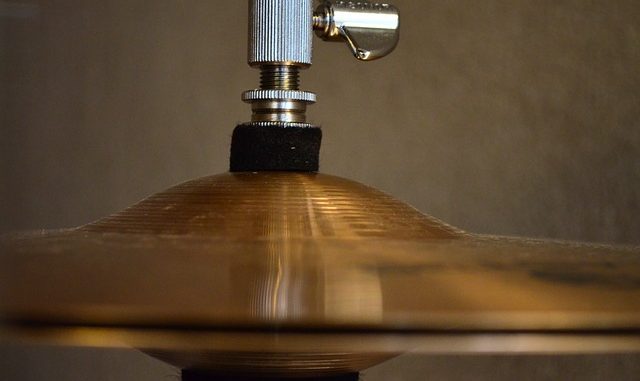
Recording a drum kit can be a real challenge, every different drum and cymbal within the kit has its own nuances and unique character, and the hi-hat is no exception. Finding the best hi-hat mic can go a long way to making sure you get the sound you want and capture the shine of your hats.
The hat is up there with kick and snare drums in terms of importance to the kit and overall sound. We’ve reviewed a few options which are perfectly suitable for this part of the drum kit.
Some audio engineers choose not to mic up the hi-hats specifically and rely on the microphones on the snare drum or drum overheads to pick up the sound of the hats. This can sometimes be effective, and good drum recordings have been made with as few as three microphones, but in the modern age we can control every detail, and having a microphone on your hats can give you an extra element of control over the sound of your drum recording.
It may be that you end up blending in some of the overall sounds of the kit from a room microphone or overheads, but that should be your choice. Only by having mics on your hi-hats can this level of detail be yours.
View Our Recommended Hi Hat Mic
Best Hi-Hat Microphone Reviews
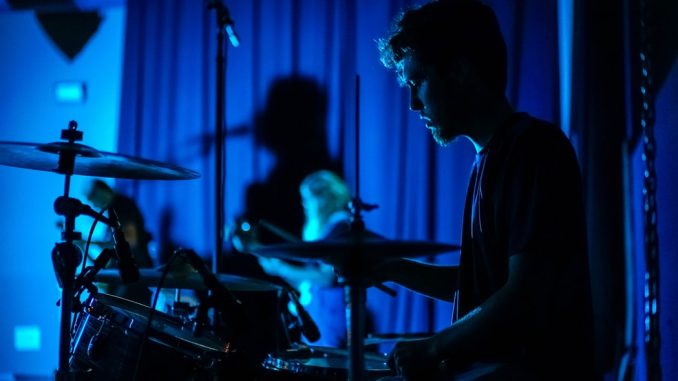
The following models are all suitable for recording hi-hats or for live use, and we’ve tried to provide different products at different prices. Even if you need a cheap hi hat mic you can find something that is up to the task and provides clear audio.
1. AKG Pro Audio C451B Instrument Condenser Microphone – Best Overall Hi Hat Mic
AKG is a brand which truly has a mic for all occasions, and their offering in the world of Cardioid, small diaphragm condenser microphones gives a wonderful recording on cymbals and hats.
Not only does this AKG hi hat mic provide a huge amount of detail, the handcrafted mic capsule and ultra-low noise preamp mean that even in really tough conditions you can get top quality recordings.
A -12 dB high-pass filter is a godsend for this purpose, it avoids recordings at lower frequencies and gets rid of any rumble or unwanted sounds. Considering a hi hat’s frequencies are at the higher end of the spectrum, this won’t get rid of any frequencies you need.
This is not one of the cheaper microphones you will see, but the amazing AKG quality and clarity is worth paying for if you have the money to spare. The first iteration of this microphone was released in the 60s, and it has been industry standard ever since. Truly a mic that will add a huge amount to your live or recording arsenal.
Check The Current Price of the AKG C451B
2. Rode NT5 Compact – Best Value for Money Hi-Hat and Overhead Microphones
Rode is a brand which doesn’t have as long a history as some of its competitors, but still offers a huge amount, and has become commonplace in home studios and even professional studios.
The NT5 compact is a small diaphragm condenser and fits the criteria set out for the best hi-hat microphone, they’re flexible and durable, with a wide frequency pickup pattern. This can be purchased on its own or as a matched pair, and these versatile mics can be used for percussion and other instruments.
Features of the NT5 include:
- A tight cardioid microphone perfect for close-micing percussion.
- Gold spluttered, compact capsule.
- Versatile mic which can be used on woodwind, brass and stringed instruments as well as drums.
- Available as a matched pair as well as on its own.
The NT5 is somewhere in the midrange in terms of price, and offers a good amount of quality and clarity at a price that isn’t going to make you scoff. That’s why we’ve named it as a value option. They’re sold as matched pairs, which is an added bonus, and means you can mic up multiple hi hats or use them as complete drum overheads.
The fact that these can be used for lots of other applications goes some way to justify the cost. Excellent quality from a brand growing in reputation.
Check The Price of the Rode NT5
3. Samson CO2 – Cheap Hi Hat Mics
Samson is not a brand you’re likely to see at a high-end recording studio, but that doesn’t mean they should be ignored. With their pencil mic, the C02, they have an offering that doesn’t break the bank but can still be a passable option for the home studio. It certainly is an upgrade on not hat mic at all!
A quick look at the reviews on Amazon or other online retailers shows how highly regarded this mic is in spite of its lower price tag.
As if the value weren’t enough, these are sold as a matched pair to make things even cheaper.
A cardioid pickup pattern, XLR connections and small diaphragm mean that it fits the criteria most people are looking for from drum microphones, and these are microphones that offer a lot to a home studio. On top of that, they can be used in a live environment too. In spite of being condenser microphones, they’re pretty rugged and can take a bit of a beating.
Matched pairs also make great overheads, can record things in ‘stereo’ and can be a good option for guitars, pianos and other instruments too, though they are designed mainly for drums.
Samson is one of those brands that some audiophiles may scoff at a little, but in truth, the reviews of this mic tend to be five stars. Though you shouldn’t expect the earth from microphones that can be purchased under $100, these can add a lot of control and options for your drum recordings. The perfect home studio pencil mics.
4. Shure SM57 – Best Live Hi-Hat Mic
Shure’s microphones are used in so many live environments around the world (and studios too). The Shure SM57 is known for its quality as a versatile instrument mic. It’s sibling product, the SM58, is more of a vocal mic.
The reason why the SM57 has been named as the best hi hat mic for live use is that these microphones are incredibly rugged. They can last decades, even being carted around on tour or hit inadvertently by drummers.
The Shure SM57’s frequency response isn’t up there with some of the elite condenser mics, so you might lose a bit of the “sizzle” in the top end of the hi-hat sound, but not to the point where it hinders a recording or a performance.
You can buy this microphone as a bundle so it comes with stand and XLR cable. This makes it better value. It’s also quick and easy to set up either in a live environment or in the studio. Using an SM57 on hi-hats is common, but these mics do a good job on pretty much anything. Though they don’t have the ultra high-fidelity sound we’d expect of some condenser or ribbon mics, they are great for a dynamic. This means you can use your hi hat mics for other things such as guitars.
Pretty much any audio engineer will have used an SM57 at some stage. Most will also tell you just how useful and versatile they are.
Check Current Price of the SM57
5. Sennheiser E614 Super-Cardioid Condenser Microphone
Sennheiser is another huge audio brand. They are known mainly for microphones and headphones. The E61 is a super-cardioid condenser microphone, and this makes it a superb option for hi-hats, especially if you want to isolate the recording for more control.
The level frequency response means these pick up all the detail of your hi-hat. The super-cardioid pattern also means that they can avoid bleed from other instruments onto the mic. This gives the audio engineer more control when mixing the hi hat and the rest of the drum kit.
This mic requires phantom power, and might not be as rugged for live use as some of the others, but in the studio it does a good job. The fact the frequency response goes all the way up to 20 kHz means that you can record the sound of drum sticks, the shine at the top of the frequency range for a full mix.
These microphones are a little more expensive than some others on this list. However, they make a great option in your studio, and they will do a great job as drum overheads or even for recording other instruments.
Check The Current Price of these Sennheiser Hi Hat Mics
What to Look For in a Hi-Hat Microphone
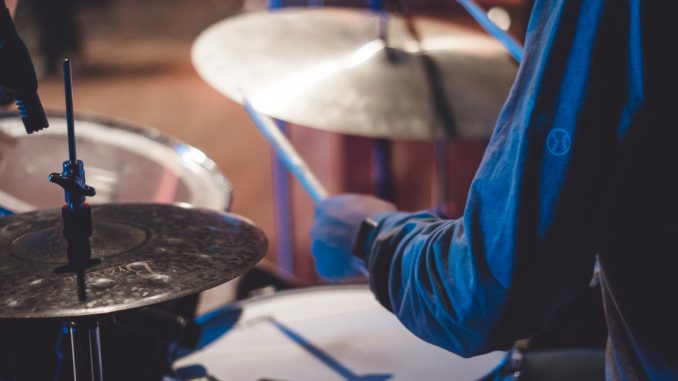
We’re looking at a few different criteria here for ensuring we get a mic that has the features we’re looking for. There are so many different types of microphone out there, and it can be easy to think they all do the same job, but this is absolutely not the case. Certain mics serve a certain purpose and as such, there is a certain profile that makes a top microphone for hi-hat recordings.
- Small diaphragm condenser microphones. The vast majority of those we’ve tried that have given good quality recordings have been small-diaphragm condensers. They’re small enough to fit around the kit without being another extra thing to accidentally get in the way, but still give a huge amount of detail and clarity to your recording.
- “Cardioid” or “Hyper-Cardioid” polar patterns. This is the pickup pattern of the microphone, and these make sure that only the specific drum you want to record will be picked up, and that ‘bleed’ or sound from the other drums being picked up will be minimal. There is no point in getting your hat mic’d up if you’re going to end up getting the snare and toms in the recording too. Using a “limiter” can also help with this.
- Price. This is always going to play a part in your decision. We’d all love to be able to spend thousands on microphones to record our drumming but it isn’t always possible. There are good options out there at many different price ranges, whether you’re looking to spend $500 or get something for under $100.
Do I Need to Mic The Hi-Hat?
This is a subject of some debate among audio engineers. In audio communities, people love to debate. This thread on DrummerWorld shows just how many differing opinions there are!
Some people say that drum overheads are more than enough. It’s definitely true that you don’t always need a specific microphone on the hi hats. However, it’s a good idea to get as much detail as you can. It’s better to have and not need, than to need and not have. If you record a hi-hat and then find in post-production that the overheads have picked up all the detail you need, this is not a problem.
If you’re recording a drummer who uses the hi-hat a lot, for intricate patterns, it is almost imperative that you use a hi hat microphone. It will be really disappointing if those hi hats go missing in the mix.
How to Mic a Hi-Hat
When micing up your hi-hats, place the mic above the top of the hat. It should be 3-4 inches above, and about halfway between the center and the outside of the hat. You can experiment with positioning, of course. If you put it more centrally, you might lose the accents of the hat sound. Place it too close to the edge and you will get a harsher sound, recording the noise of the hat moving, rather than the percussive sound you want.
It helps to see people doing this on video, so you can hear the sound of the mics, and how the positioning changes it. The following video is very helpful for a basic setup.
For further reading on micing up a whole drum kit, we recommend this guide.
Conclusion
A lot of recording comes down to technique. Different engineers have different preferences.
Some audio engineers will use around 10 mics on a drum kit, this isn’t essential, but the truth is that more options are better, and you can always choose not to use a recording once you have it. Even using an affordable hi-hat microphone to experiment and add a layer of sound to your drums.
If you have any experiences recording drums, or have your own thoughts on the best pencil mics or small diaphragm condensers for recording hi-hats or other percussion instruments, feel free to leave a comment below.






